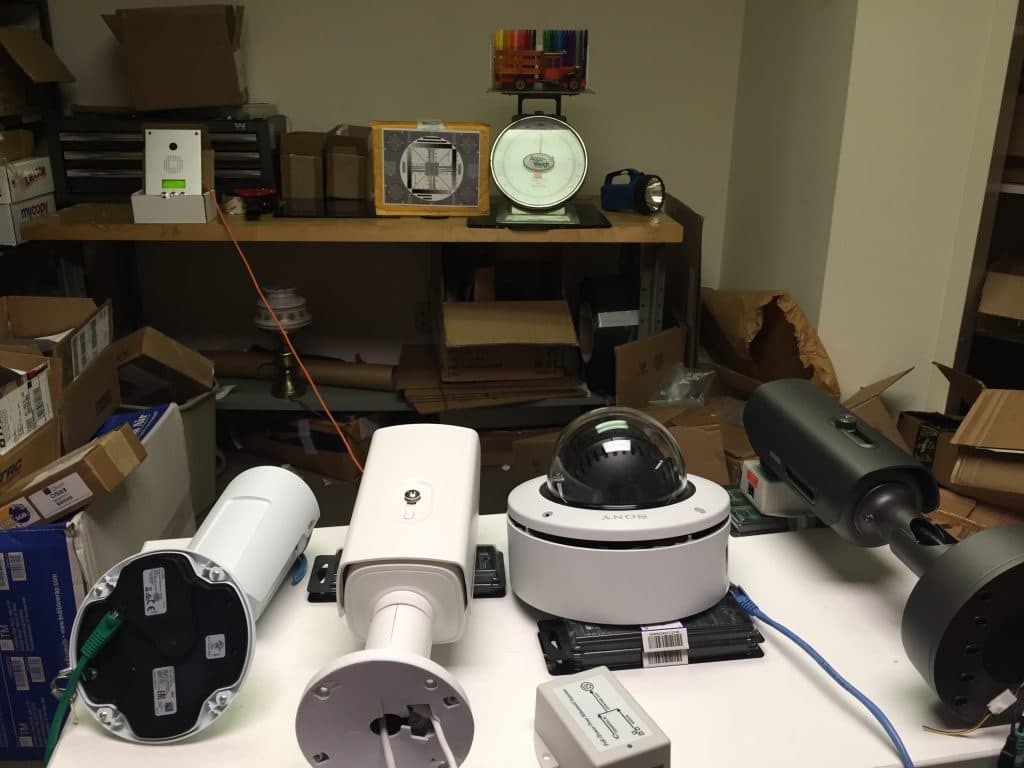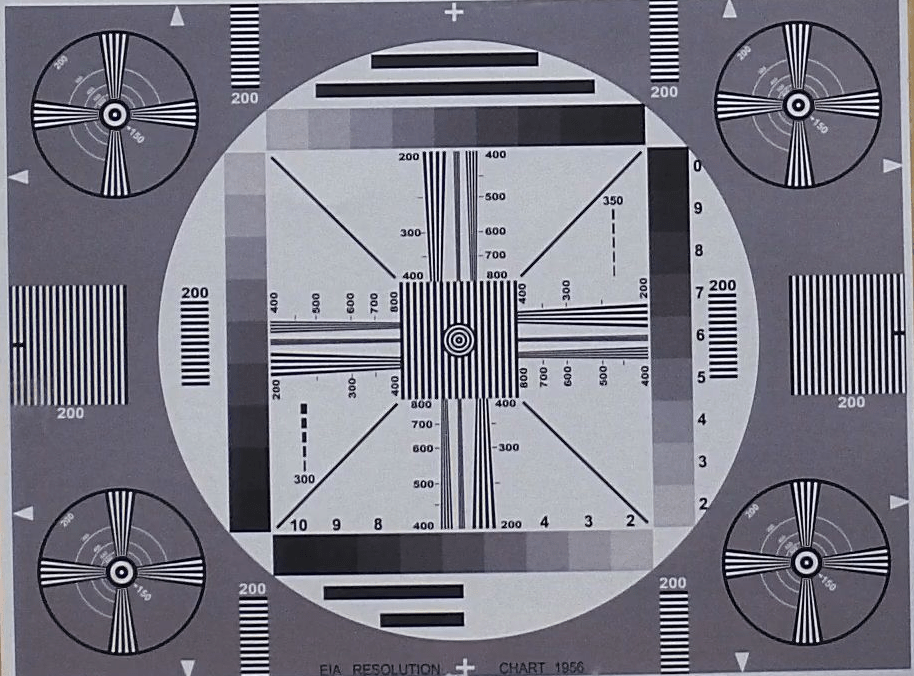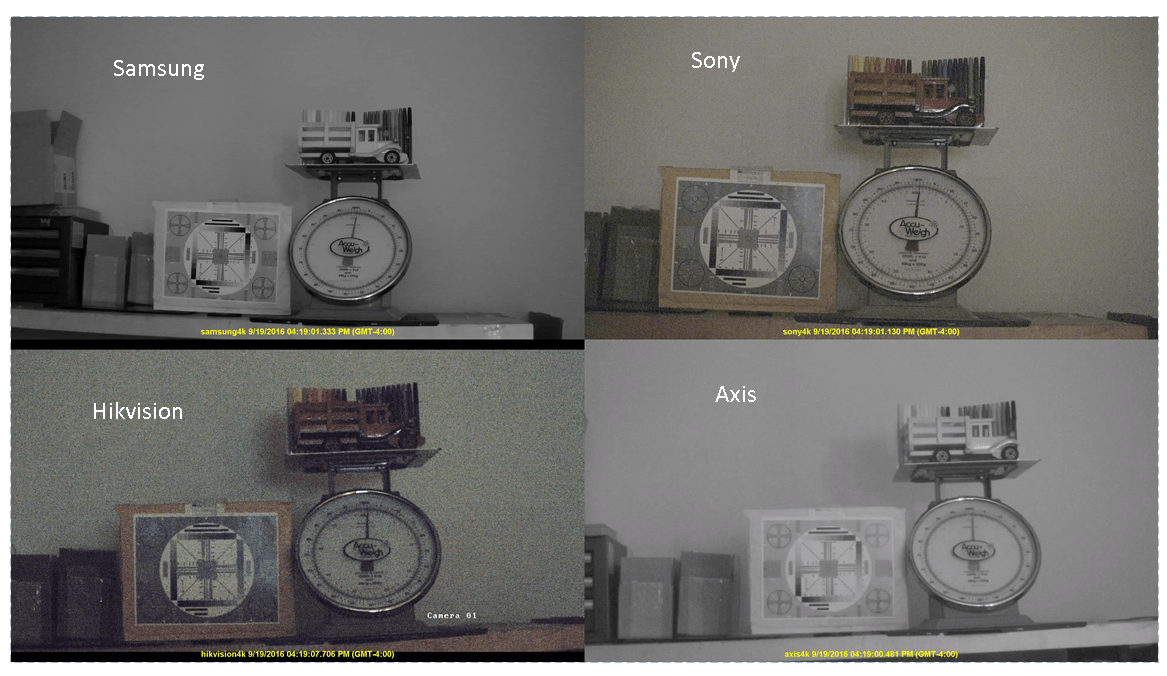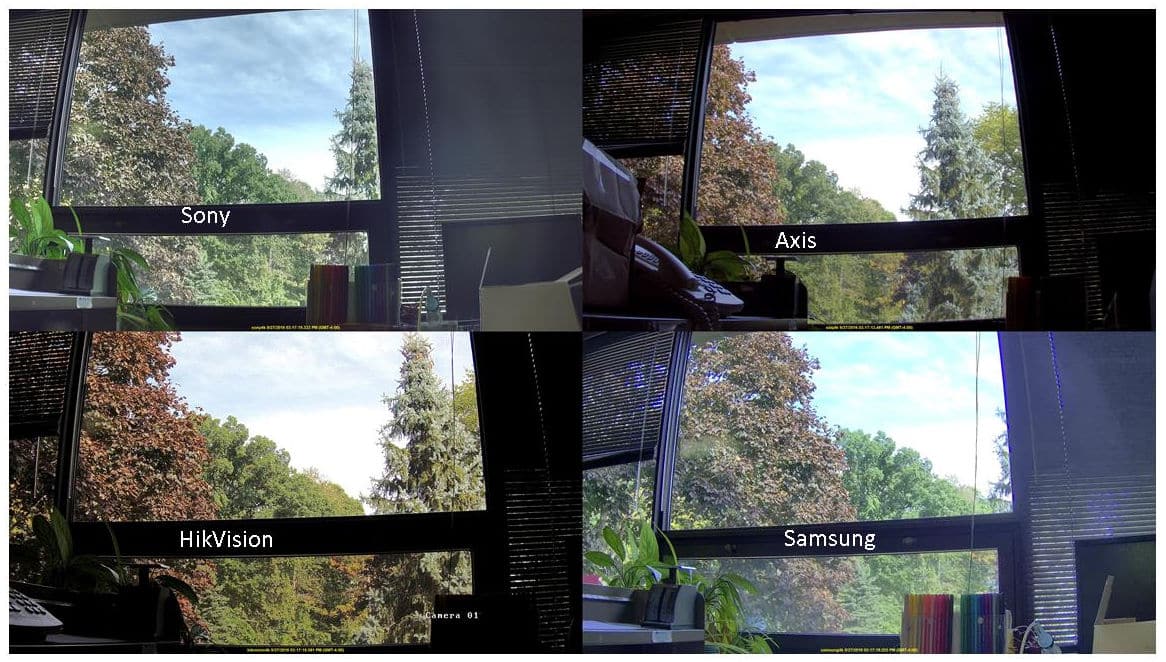Resolution, Low Light, and Wide Dynamic Range Test and Shoot-out of 4K IP Cameras
By Francisco Gutierrez-Guerra

We tested and compared 4K IP cameras from Axis, Hikvision, Samsung, and Sony.
We tested the Axis P1428-E, the Hikvision DS-2CD4A85F-IZH, the Samsung PNO-9080R, and the Sony SNC-VM772R. We tested the resolution, low light capability, signal-to-noise, and wide dynamic range.
We also looked at the latest Sony SNC-VB770, which if you can afford it, is the best 4K IP camera we have seen. Here are the results of our testing.
IP Camera Test Procedure
The cameras were tested in two environments. The first test area was in a room with no windows where we could test the resolution and low light levels in a controlled situation. The second area was a room with a large window with bright sunlight outside. This was used to test wide dynamic range (WDR). The cameras were placed side by side, and we used VMS software to view 4 cameras at the same time. We decided to keep the camera adjustments at their nominal settings. The only thing we changed was the Wide Dynamic Range (WDR) setting when we tested this function.
There is some confusion in the industry about 4K resolution terminology. The 4K label was originally used by TV display manufacturers and found its way into the surveillance camera market. This is similar to the 780p and 1080p nomenclature from the TV world. As usual, it’s confusing. The only thing that is agreed upon is that 4K displays and cameras have at least 4,000 pixels in the horizontal direction. Sony, Samsung, and Hikvision all meet this requirement, while Axis uses an 8 Megapixel sensor that is not quite up to this measure.
We tested which IP camera provided the best resolution, the lowest light capability, and the best wide dynamic range. We compared the video and captured video frames using the same test settings. The following sections describe the details about each test and the results we found.
Resolution:
Resolution was tested using normal room lighting. The cameras were placed next to each other, and their lenses were adjusted so that we could get the same field of view. We then captured the video using VMS from Exacq. We had to make sure that the video recording software captured the video at the correct resolution. We used a graphic program to digitally expand the video. This allowed us to examine the test pattern and compare the pictures from each camera.

The sensor resolution, as well as the quality of the lens, affects the maximum resolution of the IP camera. The Sony camera has the largest (20 Megapixel) sensor. Samsung uses a 12.4 Megapixel sensor, while the Hikvision camera has an 8.85 Megapixel sensor, and Axis has an 8 Megapixel sensor. Even though they all have different sensor resolutions, we set the aspect ratio to 16 by 9 (3840 x 2160) so they all appeared the same for this test.
The resolution displayed by all the cameras was very similar, with Samsung and Sony showing slightly better pictures. At lower light, the Sony and Samsung cameras had the least amount of noise. We rated the Sony and Samsung slightly higher than the Hikvision and Axis cameras.
Minimum Light Level Sensitivity
We were quite amazed at the low light performance of these very high-resolution IP cameras. Usually, the higher resolution cameras have problems at low light, but these 4K cameras did very well.
All the cameras were set at 5 fps, with WDR off and IR off. We adjusted the light level in the room so that we could compare the performance of all the cameras. The first test determined which camera stayed in color the longest as the light level was decreased. The second test measured the lowest light in black-white mode.
In general, the larger the sensor, the better the low light capability. Sony uses the largest sensor at 1”. Samsung and Hikvision both use a 1/1.7” sensor. Axis uses the smallest sensor (1/2.5”), As predicted by the sensor size, the Sony and Samsung had the best performance, while Axis had the poorest low light sensitivity. This test also demonstrated that other factors can affect low light performance, including the f-stop of the lens and the signal to noise of the video amplifiers.
Low Light Sensitivity in Color
We reduced the light level gradually until we observed the camera that stayed in color mode the longest.

The Axis camera was the first one to switch to BW mode, followed by the Samsung camera (0.3 lux). The Sony camera stayed in color as the light was reduced to about 0.2 lux.
The Hikvision was a bit difficult to test because the camera automatically turns on the IR illuminator when it switches to BW mode. We were able to turn off the IR and then the camera just stayed in color though the test. Even though this camera was always in color, it did very well. It exhibited more noise than the Sony camera, but was better than the Axis camera (which provided a more washed out image).
The Sony camera performed the best in this low light sensitivity test.
Low Light Sensitivity Test at Black-White Mode
All the cameras, except the Axis camera, include built in IR illuminators. In very low light, the cameras with IR illuminators rely on their IR light to illuminate the field of view. To get some idea about low light sensitivity, we turned off the IR. This also allowed us to determine performance outside the range of the IR illuminator,
In this test, we also turned off WDR. WDR affects the low light capability of the cameras. The light level was reduced until we couldn’t see any visible video from at least one of the cameras.

The Samsung camera was the best at low light capability. All the cameras exhibited some noise at the lowest light levels. The Sony camera does a better job than the other cameras in reducing noise and compression artifacts when there is motion. The Axis camera was the first to lose video clarity at low light. The picture shows all the cameras when the light level was reduced to about 0.1 lux.
We were surprised that Samsung was the clear winner in this test because it has a smaller sensor than the Sony camera. It exhibited some noise at the lowest light level but provided the best video image.
The new Sony SNC-VB770 was not part of our formal testing, but we were able to observe its performance in very low light situations. This is an amazing camera. It was able to provide a clear color display way below the light levels of any of our other cameras. When all the cameras had switched to BW, the Sony camera stayed in color. This is an expensive camera ($7K), and the E-type lens is more expensive than the lenses used with the other 4K cameras. But, if you need a very low light level camera and don’t want to spend the money for a thermal imaging camera (that can cost well over $20K), this is a good choice.
Wide Dynamic Range
To test wide dynamic range (WDR), we pointed the cameras at an area that had a large window in the background. We had to wait for a nice sunny day so that we could observe the light difference in the scene. We also added some objects in front of the window. We turned on WDR and made some other adjustments for this test, and observed how well each camera performed.

We looked at the details inside the room as well as outside the room. We looked at the color crayons and the scale inside, and at the trees and sky outside.
Outdoors the Hikvision camera provided a nice image with nice tree colors and blue sky color. Inside the room, we observed that the crayon colors on the right were very dark so we couldn’t make out the colors. We were not able to see the scale numbers on the left.
The Axis 4K camera had very poor contrast, both inside and outside the room. We tried to adjust the sensitivity, but when the inside was good the outdoor sky was all white. When we adjusted the sensitivity to see the sky, the inside scene was too dark. This is a typical problem when the camera has a limited dynamic range.
The Samsung, and Sony cameras displayed the blue sky, and provided good indoor contrast. The crayons were darker with the Sony camera. The Samsung camera provided a better image. We were able to clearly see the crayons as well as the scale on the left.
The Samsung 4K IP camera was the winner of this test. It had the best wide dynamic range. As a note, the specification for the Samsung camera says it provides 120 dB of dynamic range while the Sony is spec’d at 90 dB. The test matched these specifications.
What is the best 4K camera?
Based on all our testing the Samsung, PNO-9080R, 4K IP camera was the all-around winner. The resolution, low light, and wide dynamic range demonstrated that you can rely on this camera for a wide range of applications. The camera with the highest resolution was the Sony SNC-VM772R. It has a 20 Megapixel sensor with a very good lens, so if you need to really see everything possible, then select this IP camera. And, if you need the ultimate camera for low light situations at very high resolution, then the new Sony SNC-VB770 is the best choice.
When you compare the cost to the performance of all the cameras, the Samsung camera provides the best value for the money. This camera is a good choice when you need a very high-resolution IP camera for your IP camera system.
If you need help deciding on the right camera, please contact us at 800-431-1658 in the USA, or 914-944-3425 everywhere else, or use our contact form.